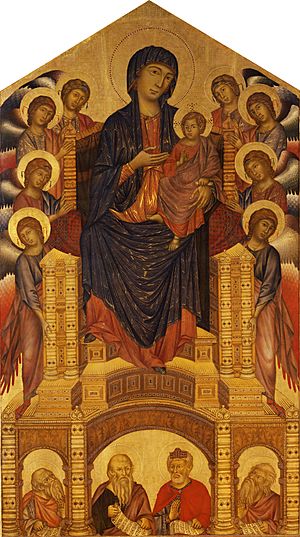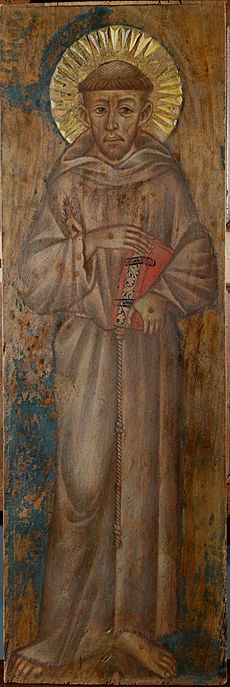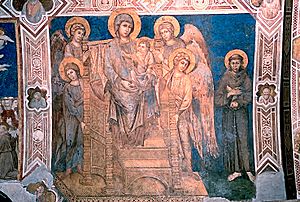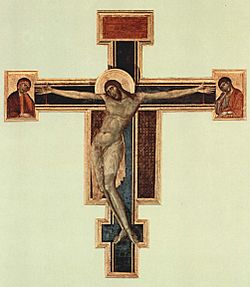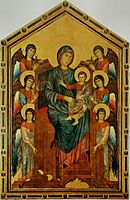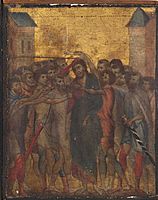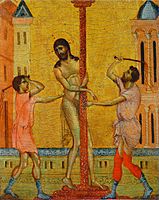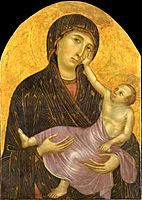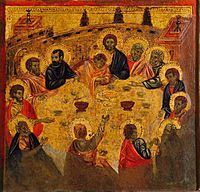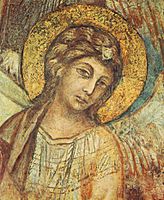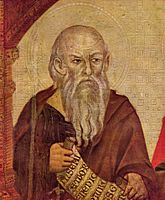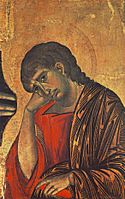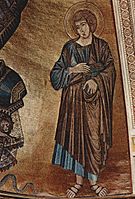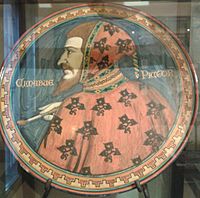Cimabue facts for kids
Cimabue, c. 1240 – 1302, was an Italian painter and designer of mosaics from Florence. He was also known as Cenni di Pepo or Cenni di Pepi.
Cimabue is regarded as one of the first great Italian painters to break from the Italo-Byzantine style. While medieval art then was scenes and forms that appeared relatively flat and highly stylized, Cimabue's figures were depicted with more advanced lifelike proportions and shading than other artists of his time.
Life
Little is known about Cimabue's early life. He was born in Florence and died in Pisa. He could have trained in Florence under masters who were culturally connected to Byzantine art.
The art historian Pietro Toesca attributed the Crucifixion in the church of San Domenico in Arezzo to Cimabue, dating around 1270, making it the earliest known attributed work that departs from the Byzantine style. Cimabue's Christ is bent, and the clothes have the golden striations that were introduced by Coppo di Marcovaldo.
Around 1272, Cimabue made another Crucifix for the Florentine church of Santa Croce. The work was larger and more advanced than the one in Arezzo.
Cimabue, while travelling from Florence to Vespignano, came upon the 10-year-old Giotto (c. 1277) drawing his sheep with a rough rock upon a smooth stone. He asked if Giotto would like to come and stay with him. The child accepted with his father's permission. During Giotto's apprenticeship, he allegedly painted a fly on the nose of a portrait Cimabue was working on; the teacher attempted to sweep the fly away several times before he understood his pupil's prank. Many modern scholars, however, say that the fact that Giotto was Cimabue's pupil is not true.
Around 1280, Cimabue painted the Maestà, originally displayed in the church of San Francesco at Pisa, but now at the Louvre. The style of the work was later followed by numerous artists, including Duccio di Buoninsegna in his Rucellai Madonna (in the past, wrongly attributed to Cimabue) as well as Giotto. Other works from the period include a Flagellation (Frick Collection), mosaics for the Baptistery of Florence (now largely restored), the Maestà at the Santa Maria dei Servi in Bologna and the Madonna in the Pinacoteca of Castelfiorentino. A workshop painting, perhaps assignable to a slightly later period, is the Maestà with Saints Francis and Dominic now in the Uffizi.
When Pope Nicholas IV became pope, Cimabue worked in Assisi. At Assisi, in the transept of the Lower Basilica of San Francesco, he created a fresco named Madonna with Child Enthroned, Four Angels and St Francis. The left portion of this fresco is lost, but it may have shown St Anthony of Padua.
Cimabue was later commissioned to decorate the apse and the transept of the Upper Basilica of Assisi. The cycle he created there comprises scenes from the Gospels, the lives of the Virgin Mary, St Peter and St Paul. The paintings are now in poor condition because of oxidation of the brighter colours that were used by the artist.
The Maestà of Santa Trinita, dated to c. 1290–1300, which was originally painted for the church of Santa Trinita in Florence, is now in the Uffizi Gallery. The softer expression of the characters suggests that it was influenced by Giotto, who was by then already active as a painter.
Cimabue spent the last period of his life, 1301 to 1302, in Pisa. There, he was commissioned to finish a mosaic of Christ Enthroned, originally begun by Maestro Francesco, in the apse of the city's cathedral. Cimabue was to create the part of the mosaic depicting St John the Evangelist, which remains the sole surviving work documented as being by the artist. Cimabue died around 1302.
Character
According to Vasari, "Cimabue of Florence was a painter who lived during the author's own time, a nobler man than anyone knew but he was as a result so haughty and proud that if someone pointed out to him any mistake or defect in his work, or if he had noted any himself... he would immediately destroy the work, no matter how precious it might be."
The nickname Cimabue translates as "bull-head" but also possibly as "one who crushes the views of others", from the Italian verb cimare, meaning "to top", "to shear", and "to blunt". The conclusion for the second meaning is drawn from similar commentaries on Dante, who was also known "for being contemptuous of criticism".
Legacy
History has long regarded Cimabue as the last of an era that was overshadowed by the Italian Renaissance. As early as 1543, Vasari wrote of Cimabue, "Cimabue was, in one sense, the principal cause of the renewal of painting," with the qualification that, "Giotto truly eclipsed Cimabue's fame just as a great light eclipses a much smaller one."
In Dante's Divine Comedy
In Canto XI of his Purgatorio, Dante laments the quick loss of public interest in Cimabue in the face of Giotto's revolution in art:
O vanity of human powers,
how briefly lasts the crowning green of glory,
unless an age of darkness follows!
In painting Cimabue thought he held the field
but now it's Giotto has the cry,
so that the other's fame is dimmed.
Market
On 27 October 2019, The Mocking of Christ, discovered the previous month in northern France in the kitchen of an elderly French woman, sold for €24m (£20m; $26.6m) at auction, setting a new record. The sale price was four times the estimate. Acteon Auction House said the sum, paid by an anonymous buyer from northern France, was a new world record for a medieval painting sold at auction.
Gallery
-
Maestà (c. 1280), Louvre, Paris
-
Virgin and Child with Two Angels (c. 1280), National Gallery, London
-
The Flagellation of Christ (c. 1280), Frick Collection, New York
See also
 In Spanish: Cimabue para niños
In Spanish: Cimabue para niños


